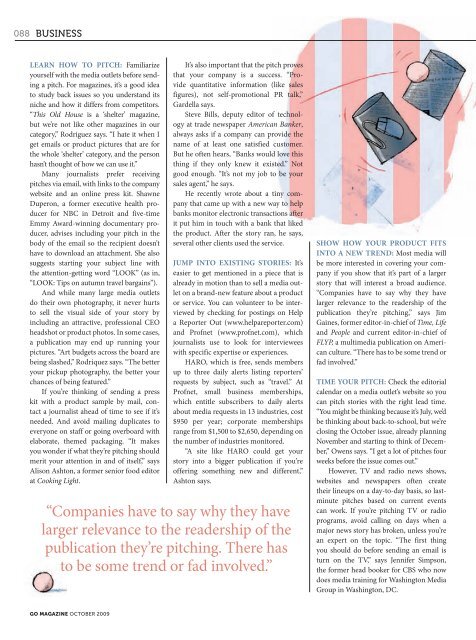You also want an ePaper? Increase the reach of your titles
YUMPU automatically turns print PDFs into web optimized ePapers that Google loves.
088 BUSINESS<br />
LEARN HOW TO PITCH: Familiarize<br />
yourself with the media outlets before sending<br />
a pitch. For magazines, it’s a good idea<br />
to study back issues so you understand its<br />
niche and how it differs from competitors.<br />
“This Old House is a ‘shelter’ magazine,<br />
but we’re not like other magazines in our<br />
category,” Rodriguez says. “I hate it when I<br />
get emails or product pictures that are for<br />
the whole ‘shelter’ category, and the person<br />
hasn’t thought of how we can use it.”<br />
Many journalists prefer receiving<br />
pitches via email, with links to the company<br />
website and an online press kit. Shawne<br />
Duperon, a former executive health producer<br />
for NBC in Detroit and five-time<br />
Emmy Award-winning documentary producer,<br />
advises including your pitch in the<br />
body of the email so the recipient doesn’t<br />
have to download an attachment. She also<br />
suggests starting your subject line with<br />
the attention-getting word “LOOK” (as in,<br />
“LOOK: Tips on autumn travel bargains”).<br />
And while many large media outlets<br />
do their own photography, it never hurts<br />
to sell the visual side of your story by<br />
including an attractive, professional CEO<br />
headshot or product photos. In some cases,<br />
a publication may end up running your<br />
pictures. “Art budgets across the board are<br />
being slashed,” Rodriquez says. “The better<br />
your pickup photography, the better your<br />
chances of being featured.”<br />
If you’re thinking of sending a press<br />
kit with a product sample by mail, contact<br />
a journalist ahead of time to see if it’s<br />
needed. And avoid mailing duplicates to<br />
everyone on staff or going overboard with<br />
elaborate, themed packaging. “It makes<br />
you wonder if what they’re pitching should<br />
merit your attention in and of itself,” says<br />
Alison Ashton, a former senior food editor<br />
at Cooking Light.<br />
GO MAGAZINE OCTOBER <strong>2009</strong><br />
It’s also important that the pitch proves<br />
that your company is a success. “Provide<br />
quantitative information (like sales<br />
figures), not self-promotional PR talk,”<br />
Gardella says.<br />
Steve Bills, deputy editor of technology<br />
at trade newspaper American Banker,<br />
always asks if a company can provide the<br />
name of at least one satisfied customer.<br />
But he often hears, “Banks would love this<br />
thing if they only knew it existed.” Not<br />
good enough. “It’s not my job to be your<br />
sales agent,” he says.<br />
He recently wrote about a tiny company<br />
that came up with a new way to help<br />
banks monitor electronic transactions after<br />
it put him in touch with a bank that liked<br />
the product. After the story ran, he says,<br />
several other clients used the service.<br />
JUMP INTO EXISTING STORIES: It’s<br />
easier to get mentioned in a piece that is<br />
already in motion than to sell a media outlet<br />
on a brand-new feature about a product<br />
or service. You can volunteer to be interviewed<br />
by checking for postings on Help<br />
a Reporter Out (www.helpareporter.com)<br />
and Profnet (www.profnet.com), which<br />
journalists use to look for interviewees<br />
with specific expertise or experiences.<br />
HARO, which is free, sends members<br />
up to three daily alerts listing reporters’<br />
requests by subject, such as “travel.” At<br />
Profnet, small business memberships,<br />
which entitle subscribers to daily alerts<br />
about media requests in 13 industries, cost<br />
$950 per year; corporate memberships<br />
range from $1,500 to $2,650, depending on<br />
the number of industries monitored.<br />
“A site like HARO could get your<br />
story into a bigger publication if you’re<br />
offering something new and different,”<br />
Ashton says.<br />
“Companies have to say why they have<br />
larger relevance to the readership of the<br />
publication they’re pitching. There has<br />
to be some trend or fad involved.”<br />
SHOW HOW YOUR PRODUCT FITS<br />
INTO A NEW TREND: Most media will<br />
be more interested in covering your company<br />
if you show that it’s part of a larger<br />
story that will interest a broad audience.<br />
“Companies have to say why they have<br />
larger relevance to the readership of the<br />
publication they’re pitching,” says Jim<br />
Gaines, former editor-in-chief of Time, Life<br />
and People and current editor-in-chief of<br />
FLYP, a multimedia publication on American<br />
culture. “There has to be some trend or<br />
fad involved.”<br />
TIME YOUR PITCH: Check the editorial<br />
calendar on a media outlet’s website so you<br />
can pitch stories with the right lead time.<br />
“You might be thinking because it’s July, we’d<br />
be thinking about back-to-school, but we’re<br />
closing the October issue, already planning<br />
November and starting to think of December,”<br />
Owens says. “I get a lot of pitches four<br />
weeks before the issue comes out.”<br />
However, TV and radio news shows,<br />
websites and newspapers often create<br />
their lineups on a day-to-day basis, so lastminute<br />
pitches based on current events<br />
can work. If you’re pitching TV or radio<br />
programs, avoid calling on days when a<br />
major news story has broken, unless you’re<br />
an expert on the topic. “The first thing<br />
you should do before sending an email is<br />
turn on the TV,” says Jennifer Simpson,<br />
the former head booker for CBS who now<br />
does media training for Washington Media<br />
Group in Washington, DC.
















